Last updated on January 29, 2024
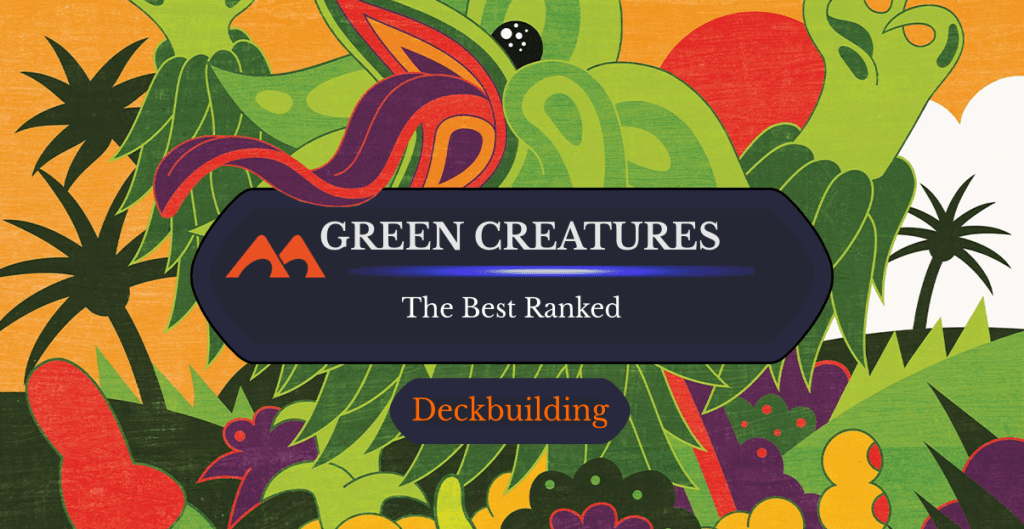
Vengevine (Secret Lair) | Illustration by Roman Klonek
Green is the color of mana, abundance, and growth. And beefy creatures. It relies on creatures for everything, from generating more mana to color fixing, and even effects that other colors can get naturally.
You can’t have a green spell that says “destroy target creature,” but you can have your creature fight a lesser one. You can also draw a lot of cards with an effect that says “draw cards equal to the greater power among creatures you control,” and for green to be good you really need a 4/4 or a 5/5 in play at least.
Today I'm ranking the best 37 green creatures that MTG has to offer across all sets. It’s going to be a wild ride, so let’s sit tight and enjoy!
What Are Green Creatures in MTG?
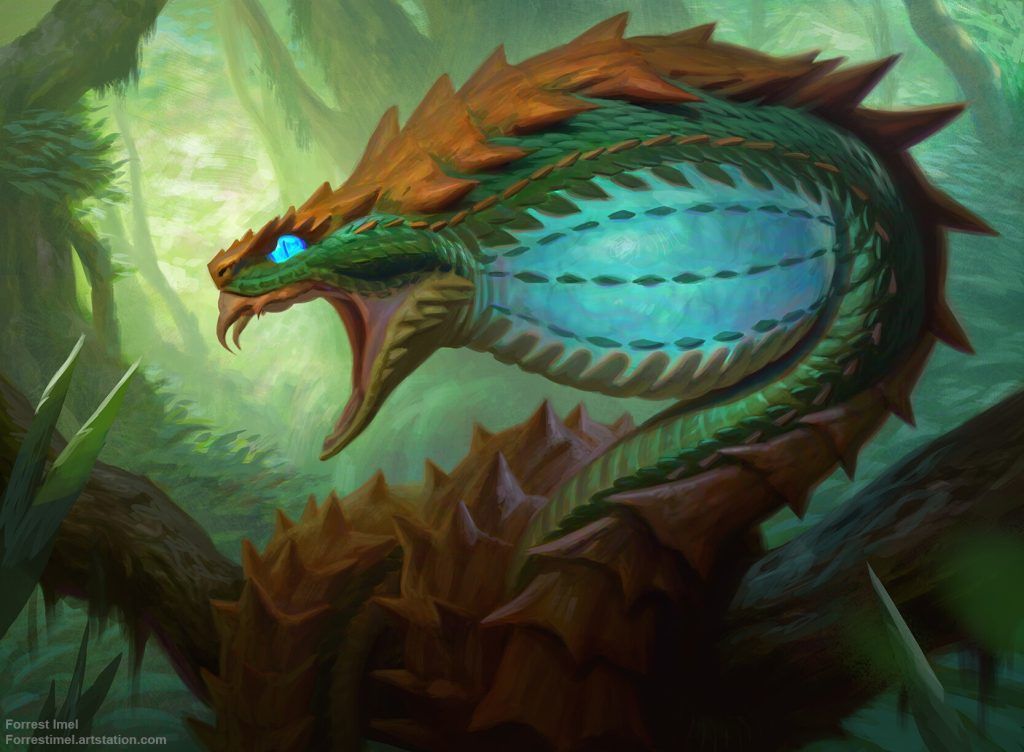
Hexdrinker | Illustration by Forrest Imel
Green creatures are creature cards with only or generic mana in their mana cost. Creatures are the bread and butter of an MTG deck, especially in green. Green creature decks come in different flavors: Either you’re ramping a 4- or 5-drop early with lots of mana dorks and some payoffs later in the curve, or you’re playing the elf-ball game with Elvish Visionary and maybe Beast Whisperer to draw cards. Of course, there’s more to it than that, but the capability to generate mana, whether mono-green or multicolor, is key to almost all green decks.
In this list I’m not considering gold creatures, like creatures for example, or creatures that are hybrid green and something else. These are the main criteria I’m considering, so let the rankings begin!
#37. Bloom Tender
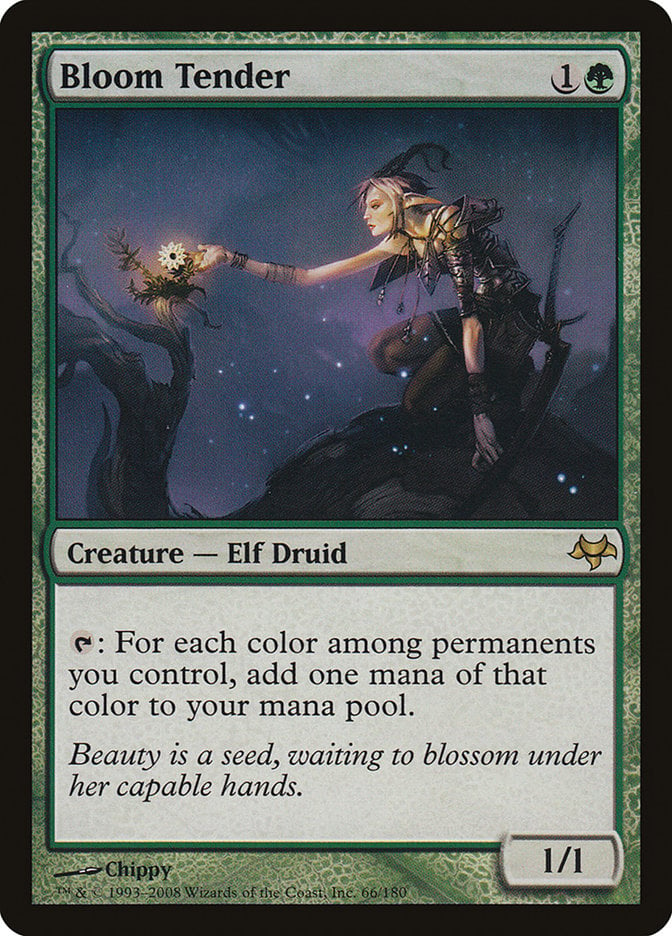
The ability to generate three to five mana alone in EDH makes this a premium mana dork for five-color decks. Just playing Bloom Tender alongside gold cards will already be worth it, let alone a card like Atraxa, Praetors' Voice.
#36. Azusa, Lost but Seeking
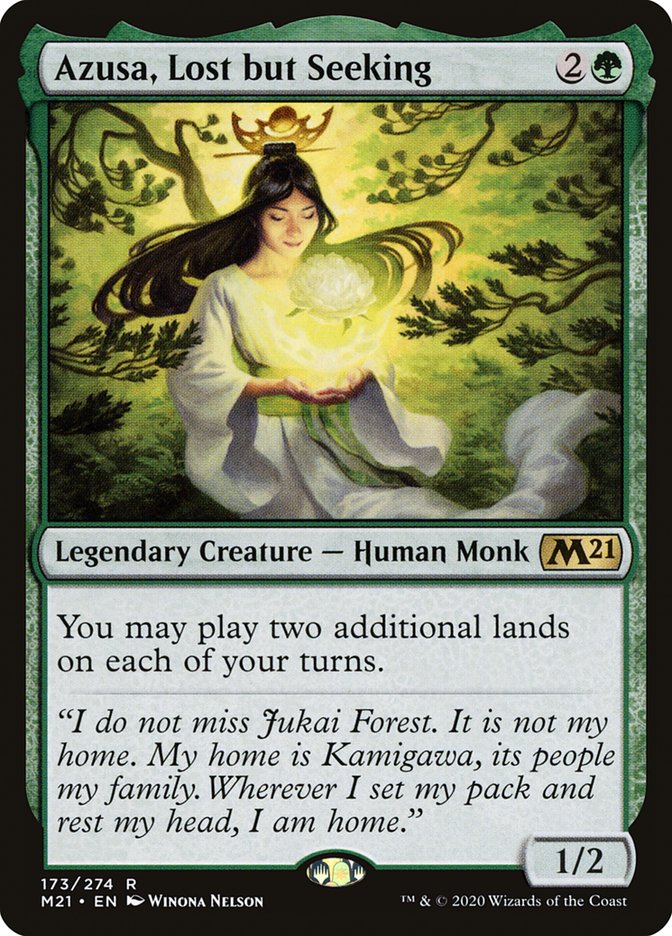
Azusa, Lost but Seeking allows you to play two additional lands each turn, and for that ability she used to be a staple in Modern Amulet decks. It’s a nice Commander card that allows you ramp unfairly provided that you have lots of lands or at least some bounce lands.
#35. Worldspine Wurm
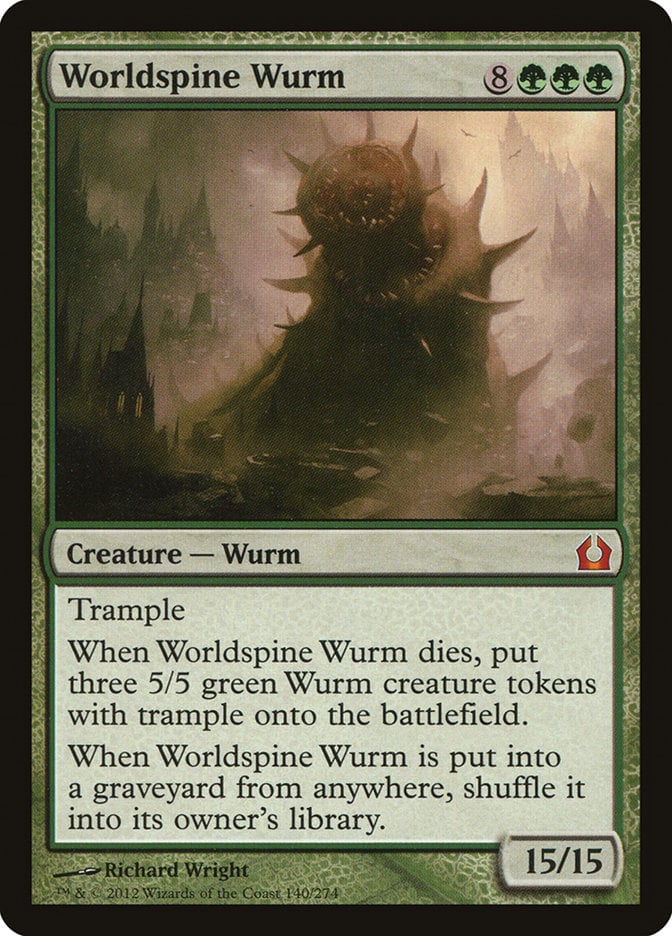
Worldspine Wurm has the keyword BIG. A 15/15 trample is likely to win you the game, but we’re usually not interested in casting a creature that costs 11 mana. The Wurm is usually cheated into play or revealed from your hand in order to use the massive stats. Cards like Indomitable Creativity or other Polymorph effects can be used for that.
Also, it’s not a win condition like Protean Hulk, but Worldspine Wurm is a nice target for Flash as well, since you’ll get three 5/5 tokens after sacrificing it.
#34. Beast Whisperer
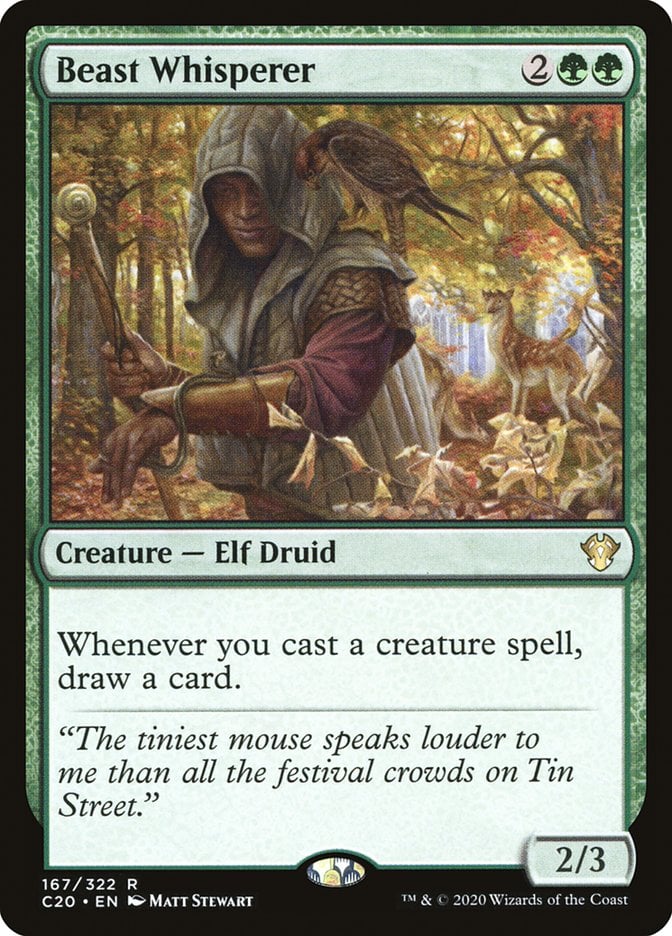
Green decks want to cast lots of creatures, so Beast Whisperer is your payoff here. Toss him into an elf-ball deck, and he’ll give you a card each time you cast a creature spell, and in a good turn you can easily refill your hand.
#33. Argothian Enchantress
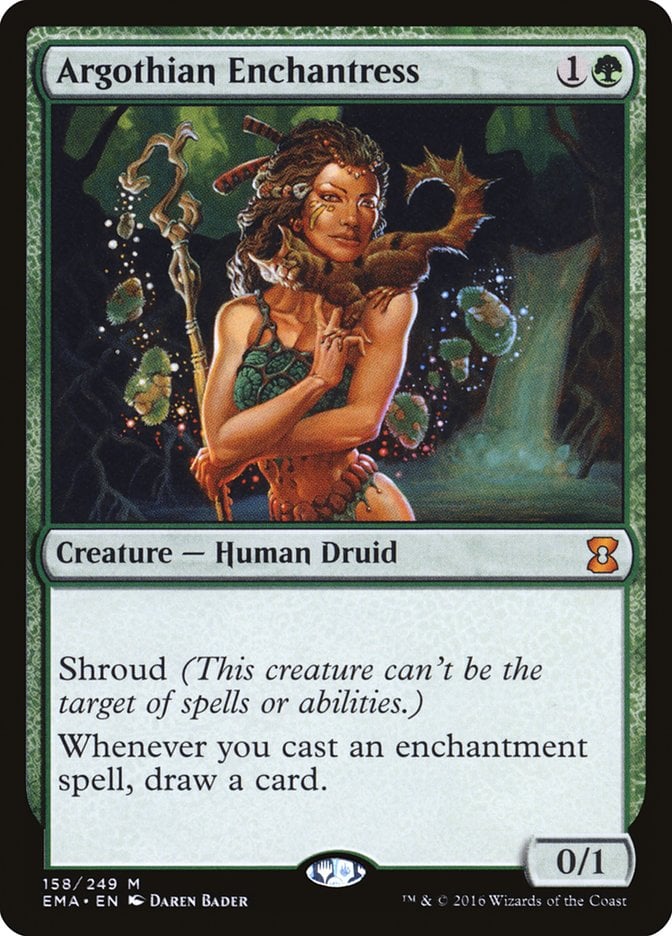
Besides having shroud, which is basically protection from spot removal, Argothian Enchantress is the cheapest way in green to draw cards from enchantments you play. Creatures like this card are usually the base of the Enchantress archetype, where you want to play lots of enchantments to draw a bunch of cards and grind your opponents out. Verduran Enchantress is another card that complements the strategy well.
#32. Tireless Tracker

The usual play pattern with Tireless Tracker is to cast it and follow with a land or fetch land so you’ll at least get a Clue token. Creating a bunch of Clues with Tireless Tracker is a good way to get an edge in midrange mirror matches.
#31. Avenger of Zendikar

Ramp staple in Vintage Cube, Avenger of Zendikar generates a lot of value when it ETBs. The tokens will grow with landfall triggers, can be sacrificed, and works in +1/+1 counter synergy decks. If Doubling Season is already in play, you’ll have lots of calculations to do. Easy to include card in EDH decks looking for a 7-drop too.
#30. Lovestruck Beast
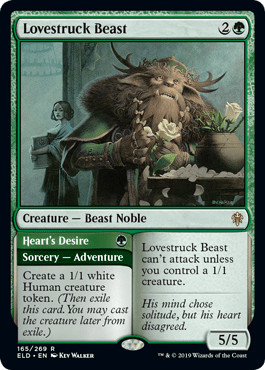
A 5/5 for three mana? And’s not even ? That’s pushed beyond belief. Not only that, but it can make a 1/1 token via the adventure ability. So, you’ll get a 1/1 and a 5/5 in the same card. Lovestruck Beast’s only downside is that it needs a 1/1 to be able to attack, but between the token and some Llanowar Elves, you’re all set. At least it blocks really well against aggro decks.
#29. Hexdrinker
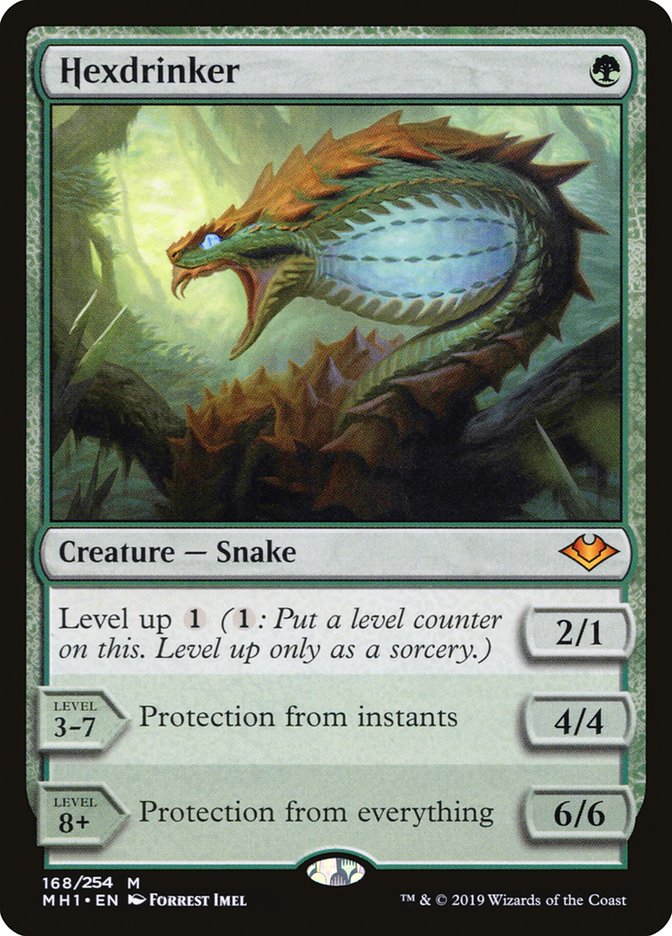
Probably the best offensive green 1-drop, Hexdrinker is a house. It’s basically a 2/1 for green, which is what you’d expect from an aggressive creature. With a little mana investment via the level up mechanic, Hexdrinker can be a 4/4 that has protection from instants, and that’s already a hell of a card. A card that can perform multiple roles as an early aggression, and a “protection from everything” late-game threat is very good.
#28. Oracle of Mul Daya
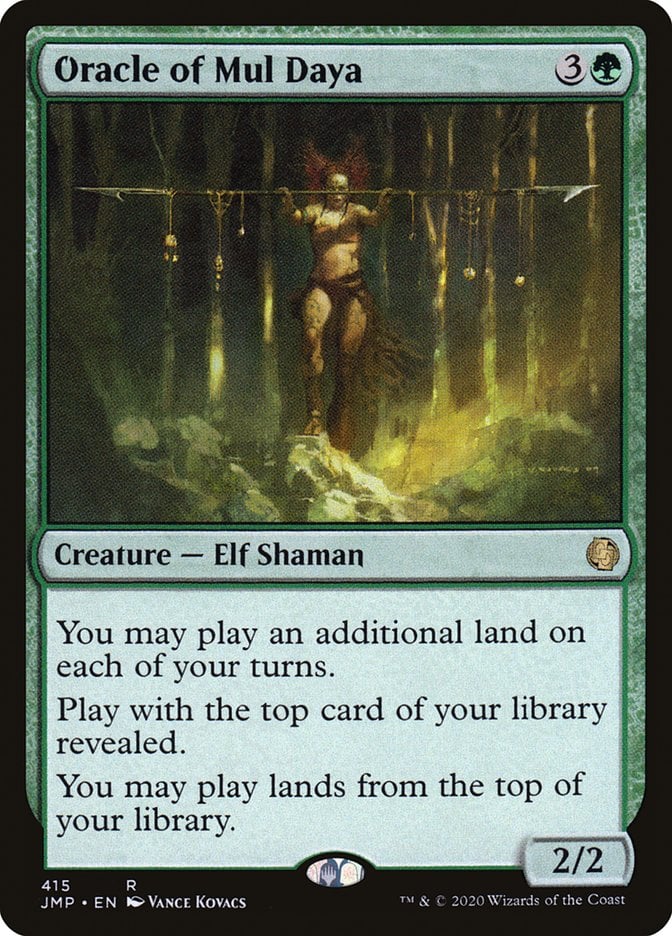
Don’t let the fragile 2/2 body deceive you. The combination between playing more than one land a turn and being able to play lands from the top of your library is very efficient, and sometimes you’ll untap with Oracle of Mul Daya and play two lands from the top of your library, effectively ramping and getting card advantage.
#27. Esika, God of the Tree / The Prismatic Bridge
Esika, God of the Tree turns all your legendary creatures into Birds of Paradise. That’s nice. I wonder if that’s good in EDH, in decks full of legendary creatures… (yes, it is). But the nicer part of Esika is that you can have her as your commander and cast the other half, which is The Prismatic Bridge. This way you can play a five-color EDH deck and get a free creature or planeswalker card every turn. That makes for a really nice superfriends or gods-based EDH deck.
#26. Dryad of the Ilysian Grove
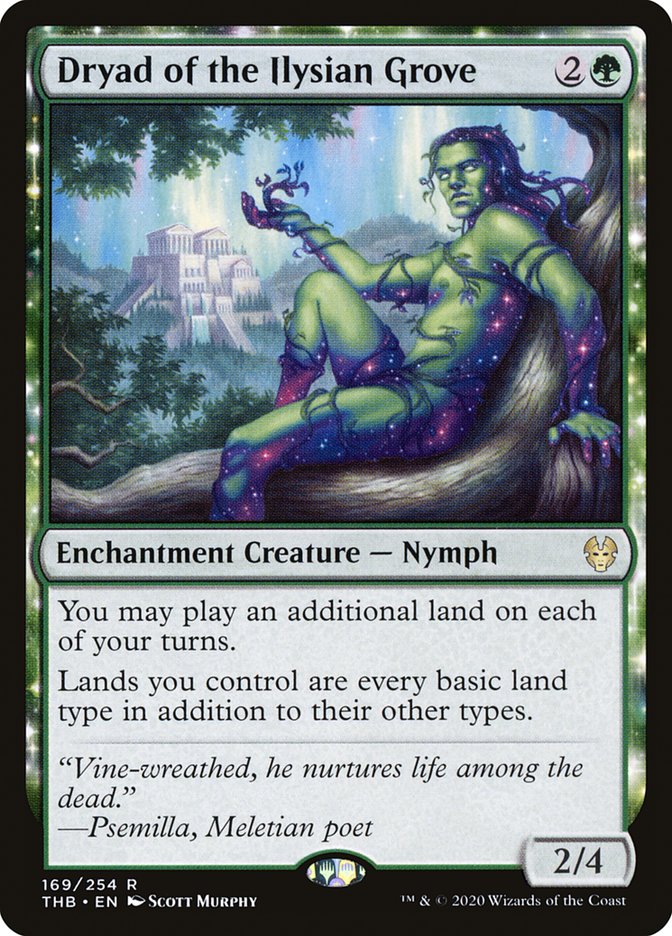
Dryad of the Ilysian Grove is a good mix between Oracle of Mul Daya and Courser of Kruphix. Only that you can’t see the top card of your library and play it from there, which is an extraordinarily powerful ability, but hey, we can play five colors now and two lands a turn. It can be better defined as having the Exploration + Prismatic Omen effect, which are very desirable in EDH and as such, make Dryad a great card.
#25. Old-Growth Troll
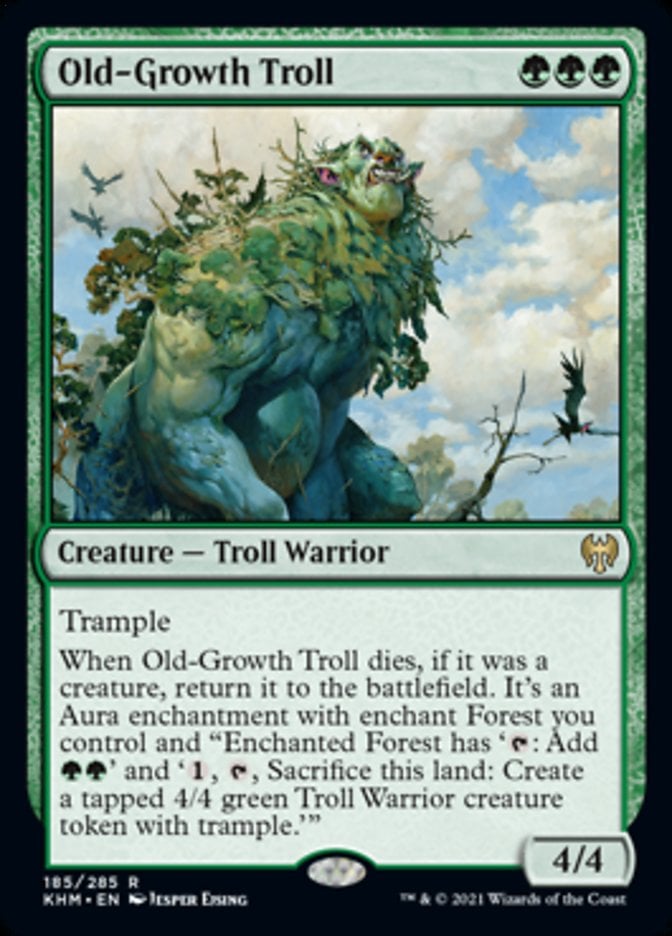
Old-Growth Troll is a 4/4 creature for three mana, easily castable in mono-green aggro decks. Besides being a very pushed card, what sets it apart is that after it dies, it becomes an aura enchanting a Forest, and you can get another 4/4 out of the deal. So, you’re basically getting two 4/4 creatures against an opponent that doesn’t exile your creatures.
#24. Hornet Queen
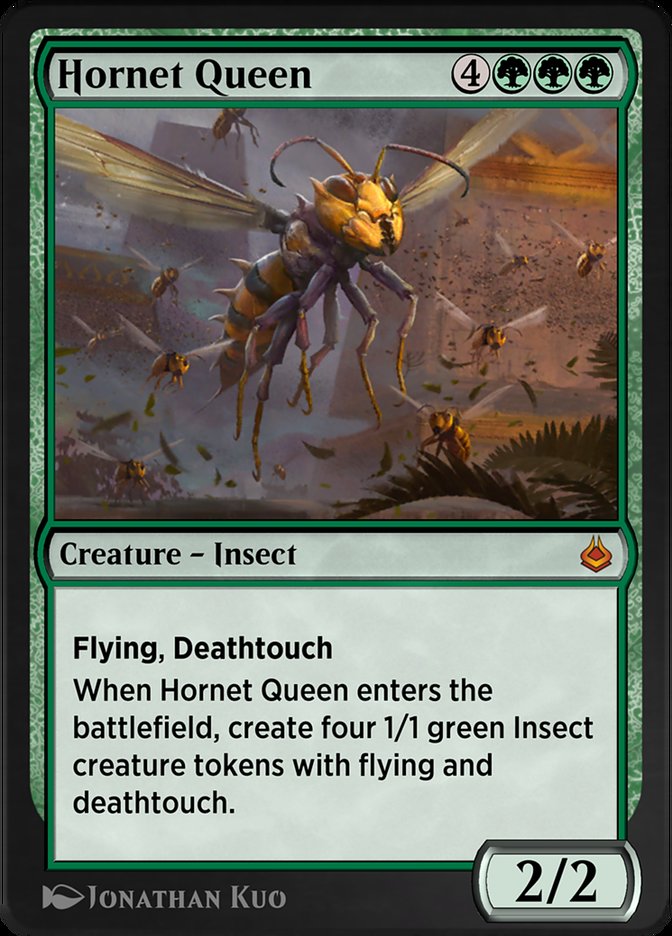
Hornet Queen puts five flying and deathtouch bodies on the table, being the ultimate defense. Who’ll want to attack you in EDH after you cast one of those? And let’s consider that if I have Fynn, the Fangbearer on the battlefield, a single attack from a Hornet Queen and its tokens can kill a player. Hornet Queen is also a nice tool in reanimator decks or decks using Karmic Guide plus Reveillark.
#23. Vorinclex, Voice of Hunger
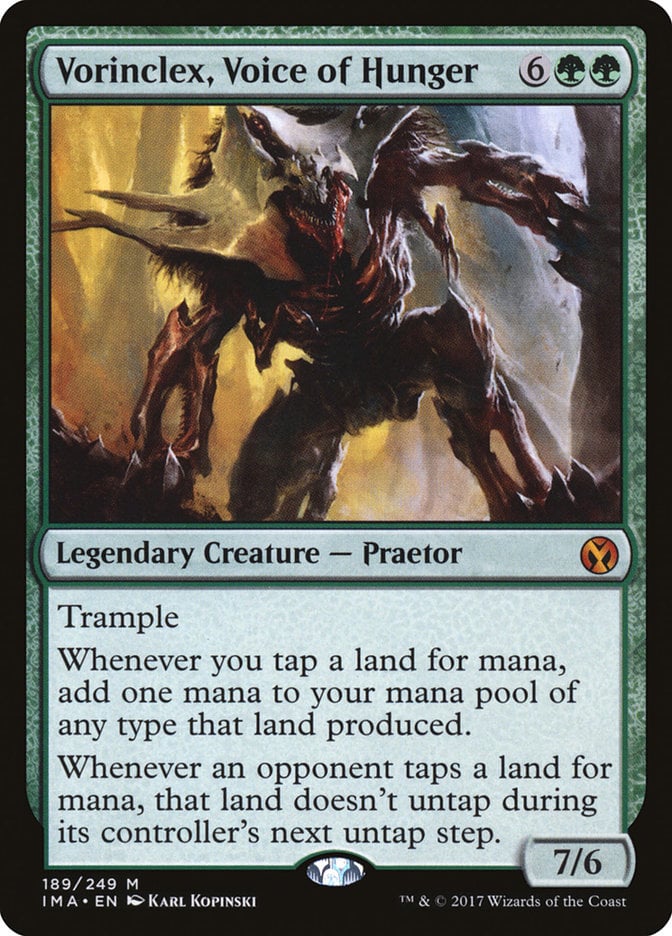
Doubling Season is very powerful in EDH, so why not staple this effect onto a commander so we can have access to it anytime from the command zone? It’s a very limited Doubling Season, I’ll admit, but Vorinclex, Voice of Hunger is a good threat by itself, and the added benefits make playing him worthwhile.
#22. Ghalta, Primal Hunger
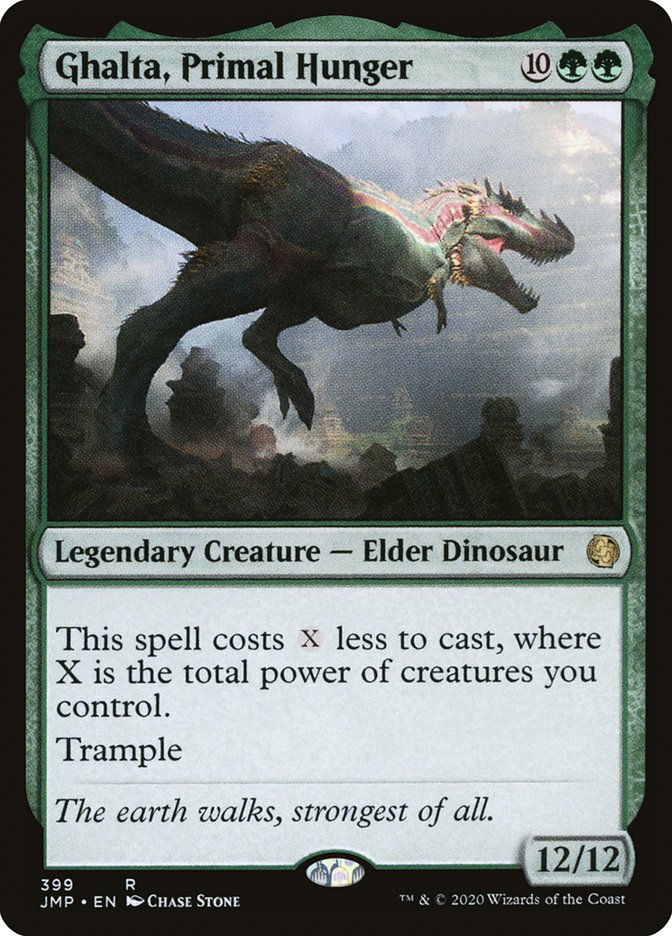
12/12 trample is good! The downside is that it costs a ton, right? Not in the right deck, since Ghalta, Primal Hunger has cost reduction based on the power of your creatures. Just having a 6/6 in play makes your Ghalta very castable. Usually in EDH, you want to give it haste with cards like Fires of Yavimaya and hit hard as soon as possible.
#21. Questing Beast
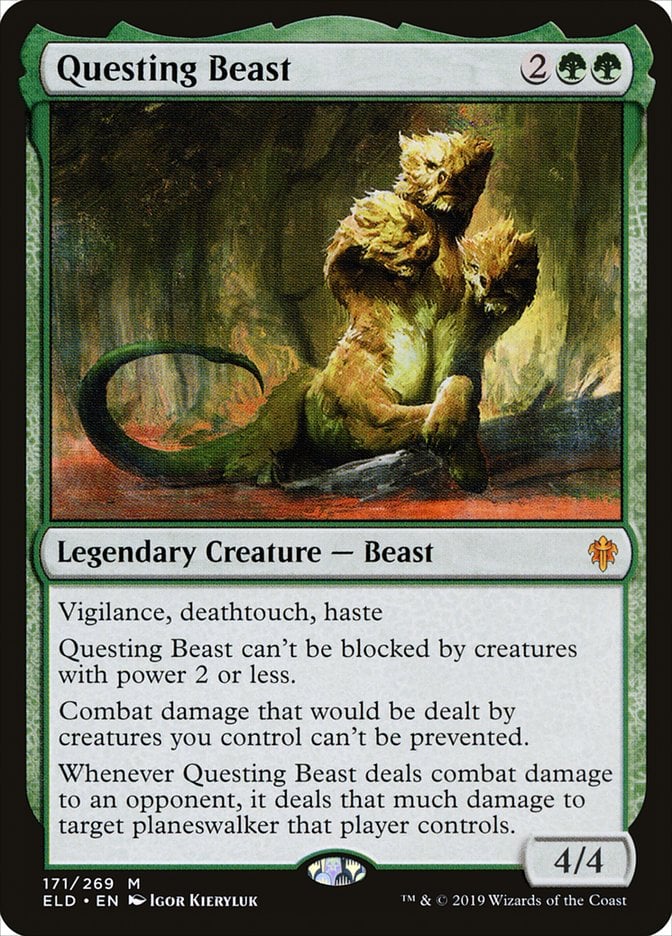
How many abilities does Questing Beast have? A ton actually, and it’s one of the most pushed 4-drops out there. The only and major weakness is that it doesn’t generate much value in the face of enemy removal, but outside of that it dominates combat, can’t be blocked by tokens, and combat damage can’t be prevented, which is very easy to forget among its many abilities. Sometimes all that Questing Beast does is attacking for four and trading or eating a removal spell, and that’s the worst-case scenario.
#20. Fynn, the Fangbearer
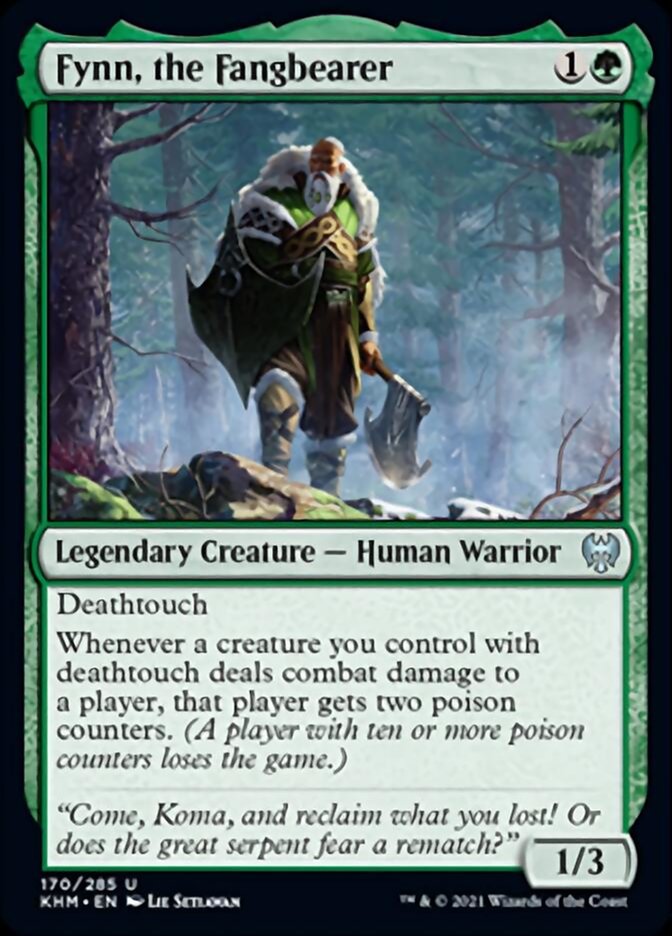
Fynn, the Fangbearer is one of the most popular commanders out there, with thousands of decklists submitted online. The deathtouch tribal decks it generates are very easy and cheap to assemble. Suddenly, each 1/1 deathtouch for one mana that’s available at common becomes a threat, effectively having toxic 2, so to speak. Five attacks from deathtouch creatures are enough to win an EDH game if you have Fynn by your side, which conveniently averts the starting 40 life condition.
#19. Collector Ouphe
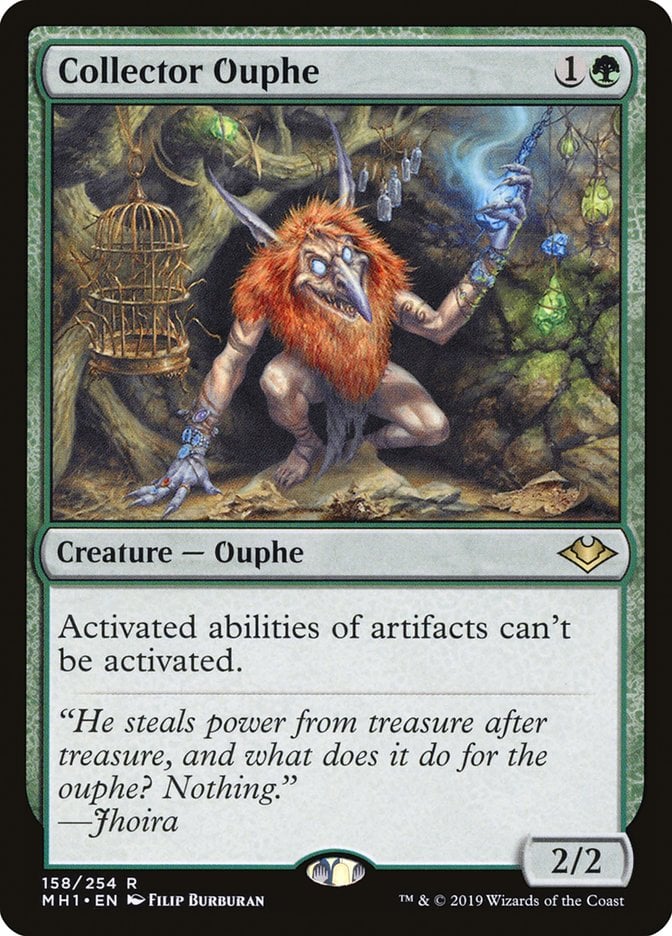
In formats ripe with artifact interaction and mana rocks, Collector Ouphe can be a real pain. This card will lock not only Sol Ring and Signets, but also cards like Isochron Scepter and equipment. Very playable in EDH as well as other Constructed formats like Modern and Vintage.
#18. Eternal Witness
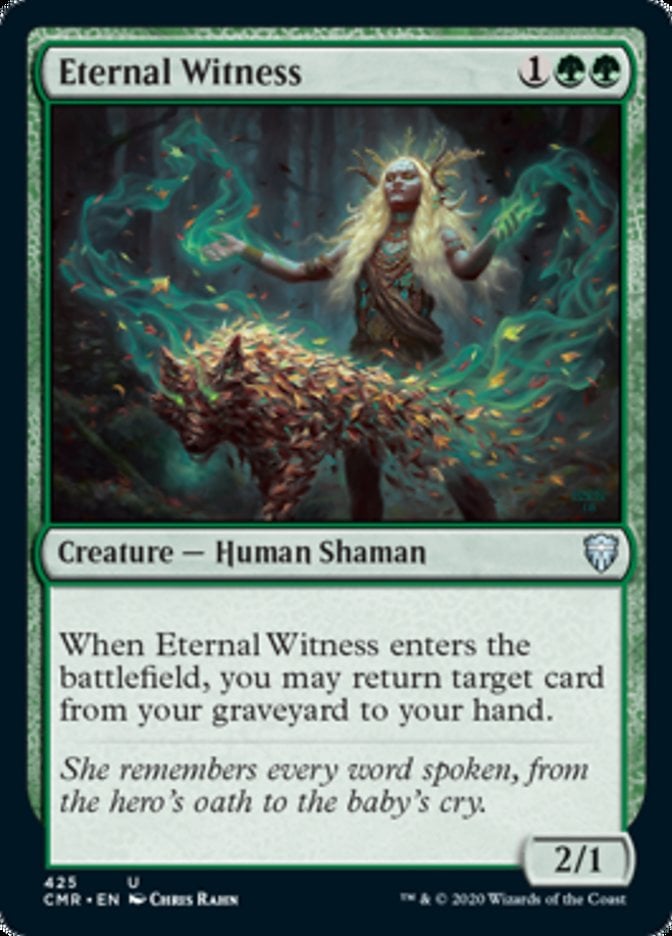
Eternal Witness is very flexible, being able to return any card from your graveyard to your hand (most cards with this effect are selective). It’s also a human, one of MTG’s main creature types, and you can exploit Eternal Witness in many ways with loops and combos. Basically, if your deck has green and a graveyard component, Eternal Witness will be there and will generate value.
#17. Lotus Cobra
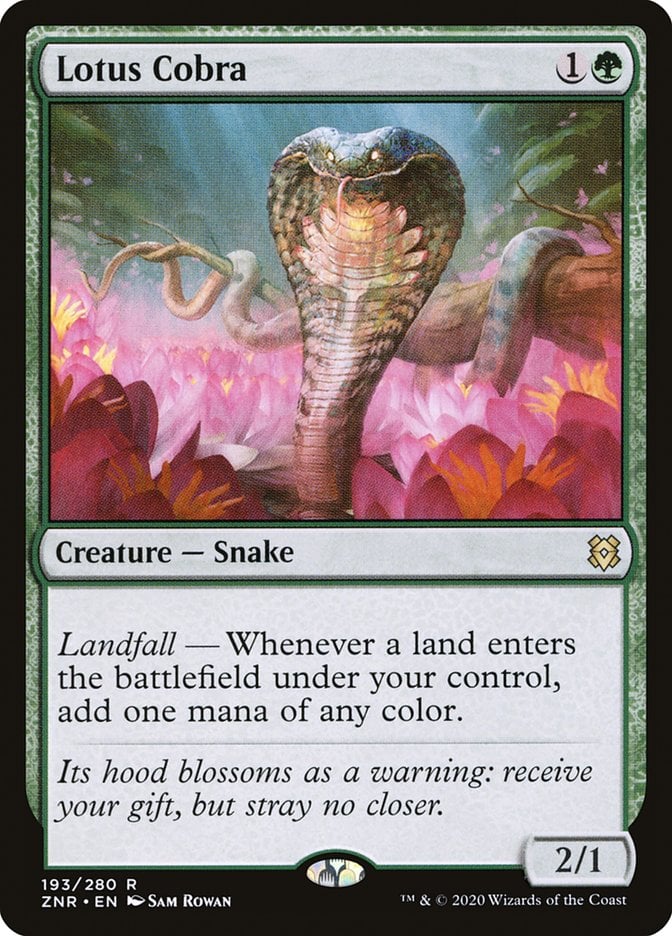
Lotus Cobra is a lowly 2/1 but it can go wild with fetch lands and landfall triggers. Playing Lotus Cobra on turn 2 will give you enough ramp ammunition to cast 4- or 5-drops the next turn with ease, and it scales very well with ramp effects that put lands into play. Also, it generates mana from any color, effectively fixing your colors.
#16. Arbor Elf
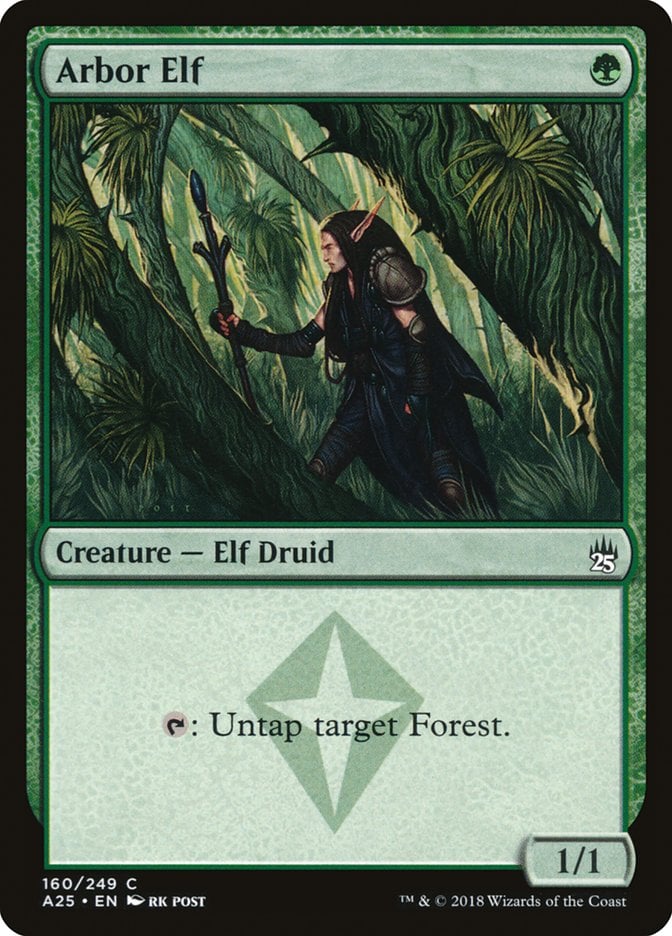
Arbor Elf differentiates itself from other mana dorks simply by untapping a land instead of generating mana. This has implications with lands that generate more than one mana, like bounce lands or lands enchanted with Utopia Sprawl and the like. There are a few Modern decks that put this combo to good use.
#15. Elder Gargaroth
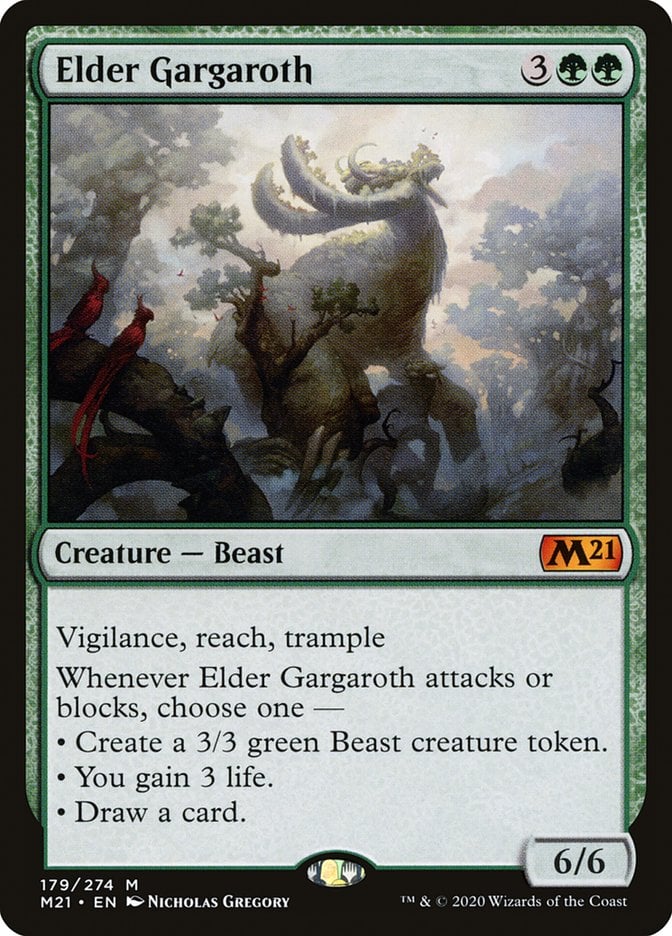
Elder Gargaroth is pure value. A 6/6 vigilance and reach for just five mana is already very pushed, but wait, there’s more. Each time it attacks or blocks, you’ll choose between making a 3/3 creature, gaining 3 life, or drawing a card. Elder Gargaroth covers all the bases, making it an awesome midrange creature.
#14. Glistener Elf
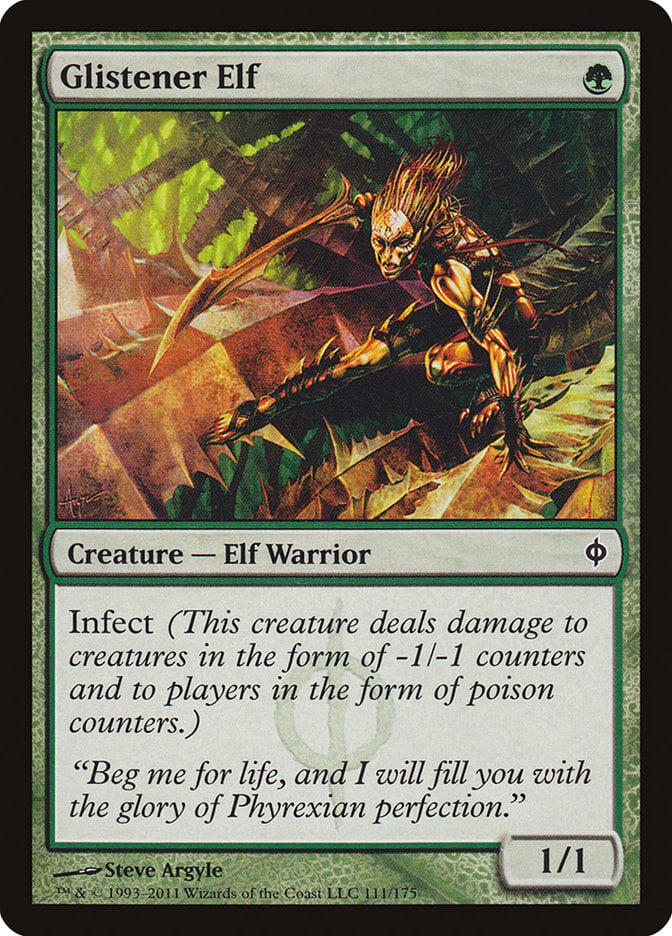
Glistener Elf gets the nod here because infect decks desperately want a 1-drop to start infecting people out. Glistener Elf with combat tricks is a very quick way to end a match.
#13. Golgari Grave-Troll
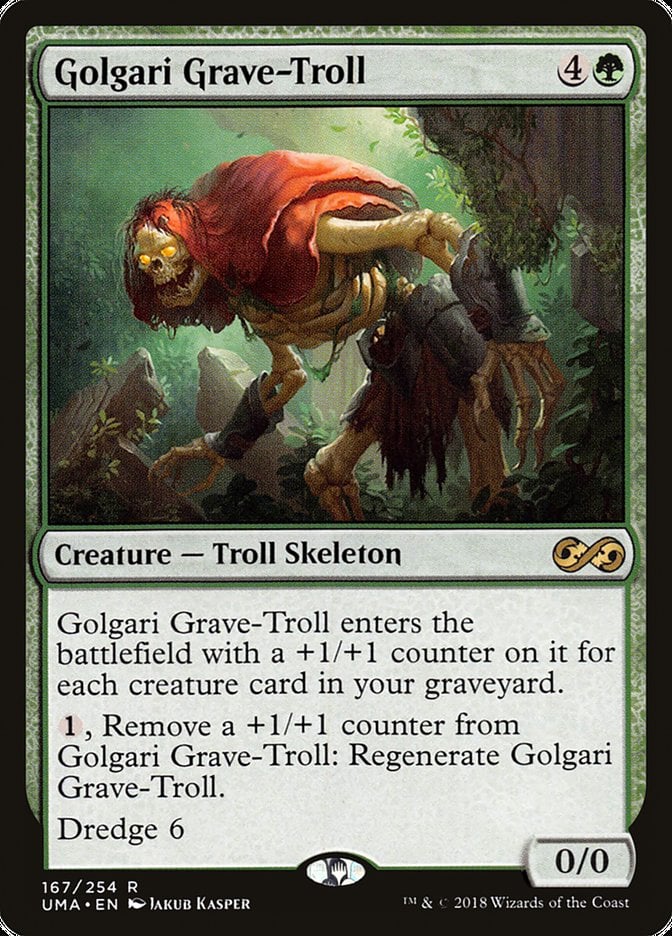
Golgari Grave-Troll’s dredge 6 ability has granted it the ban hammer in many formats. Not only the high dredge number, but Grave-Troll is also a win condition for a dredge deck (in comparison to other dredge cards like Stinkweed Imp). The combination of filling the graveyard quickly and being a big creature gives dredge decks too much power.
#12. Protean Hulk
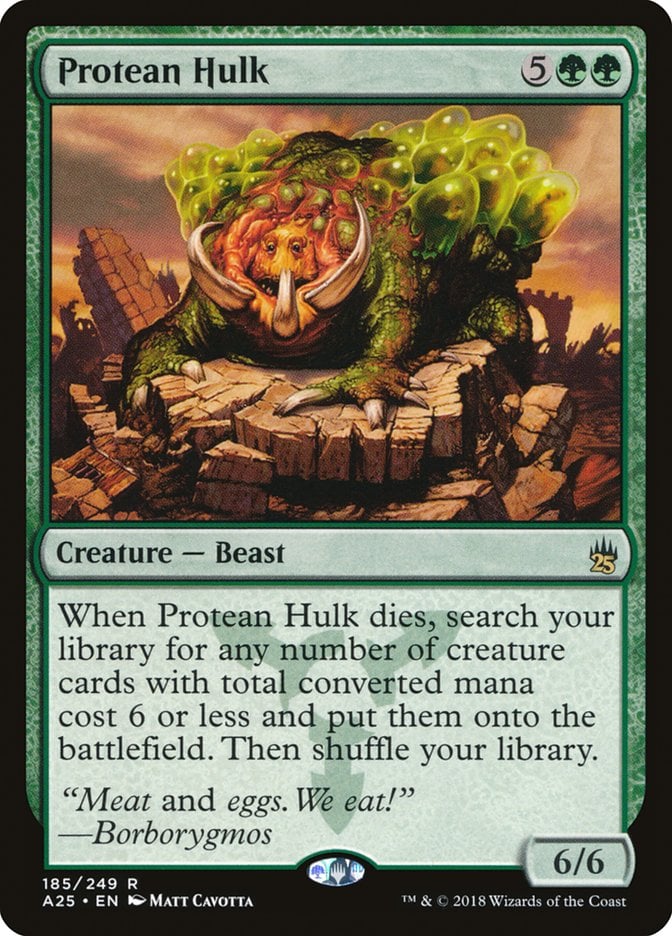
Protean Hulk is half of the famous “Flash-Hulk” combo. With both on your hands, you just need to cast Flash, which will put Protean Hulk in play, then he’ll be sacrificed and will fetch a combination of creatures needed to win from there.
#11. Nettle Sentinel
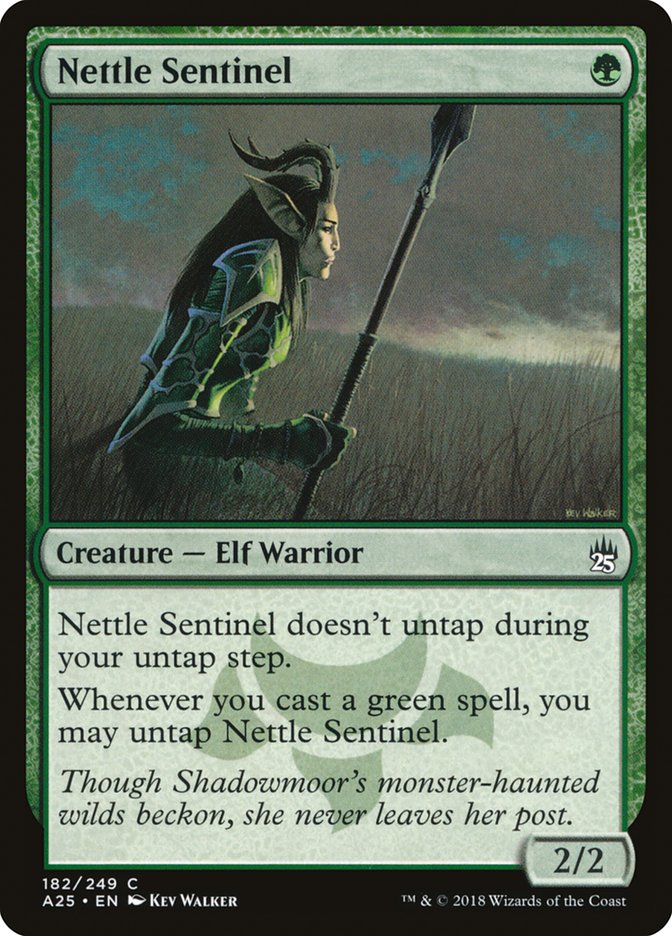
A 2/2 for one mana is an awesome rate of aggressive decks, and it has the untap function whenever you cast a green spell. The real use of Nettle Sentinel besides attacking is to abuse tap abilities, especially with Birchlore Rangers or Heritage Druid in play. As such, Nettle Sentinel has been the premier 1-drop in combo elf decks.
#10. Rofellos, Llanowar Emissary
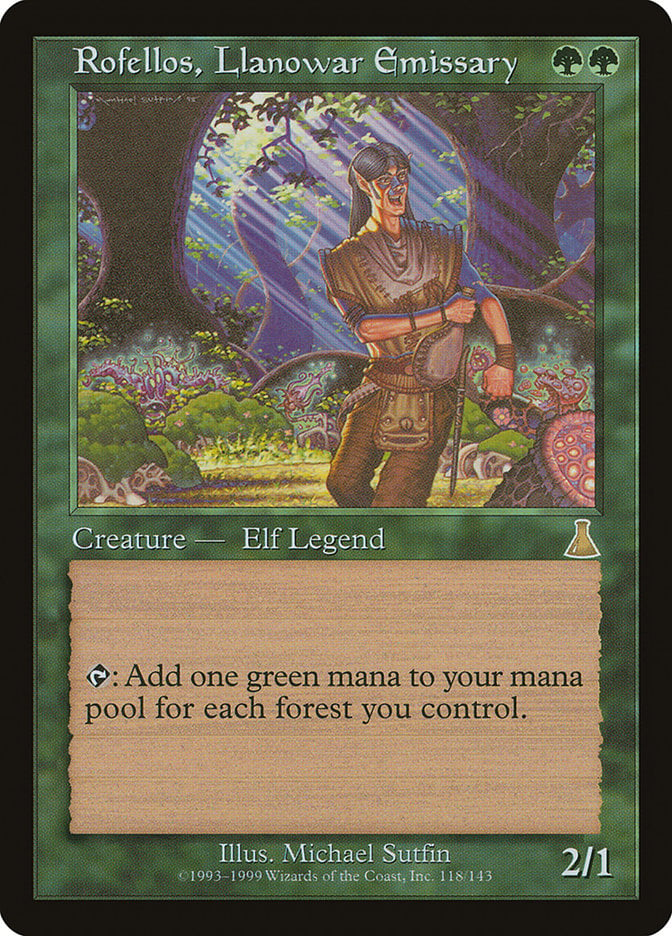
Rofellos, Llanowar Emissary is a nice Legacy card in elf decks because it will generate a green mana for each Forest you control. This can range easily from two to 10 mana, and this is one of the reasons why he’s banned in Commander and a very good first pick in Vintage Cube.
#9. Cavalier of Thorns
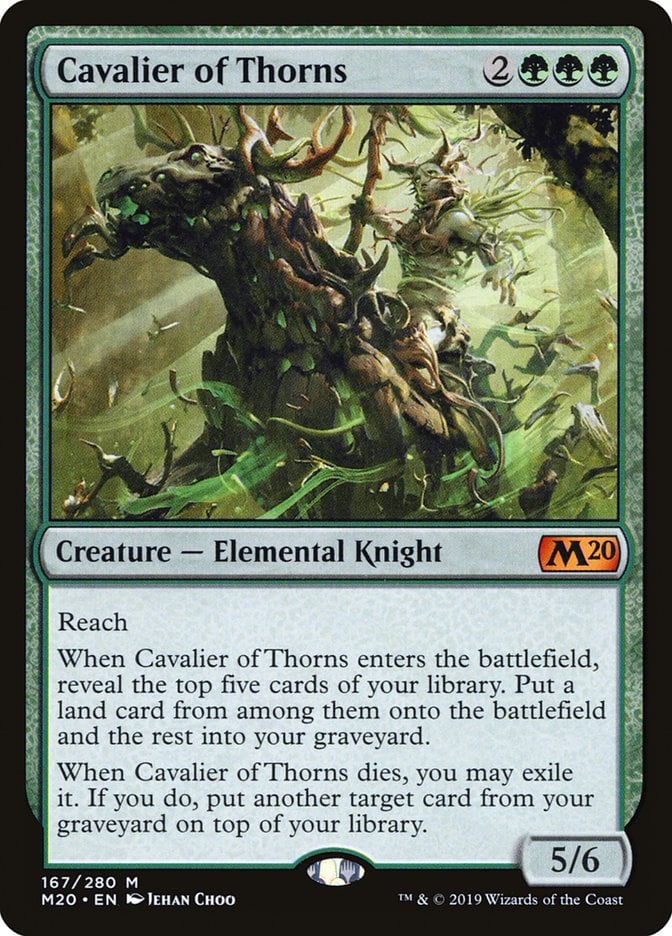
Cavalier of Thorns is a 5/6 reach for five mana that also ramps you. And when it dies, you’ll recover a key card from your graveyard. It provides triple value, both as a good body and the enters-the-battlefield plus dies triggers. It can be commonly found in Pioneer alongside Karn, the Great Creator and Nissa, Who Shakes the World.
#8. Endurance
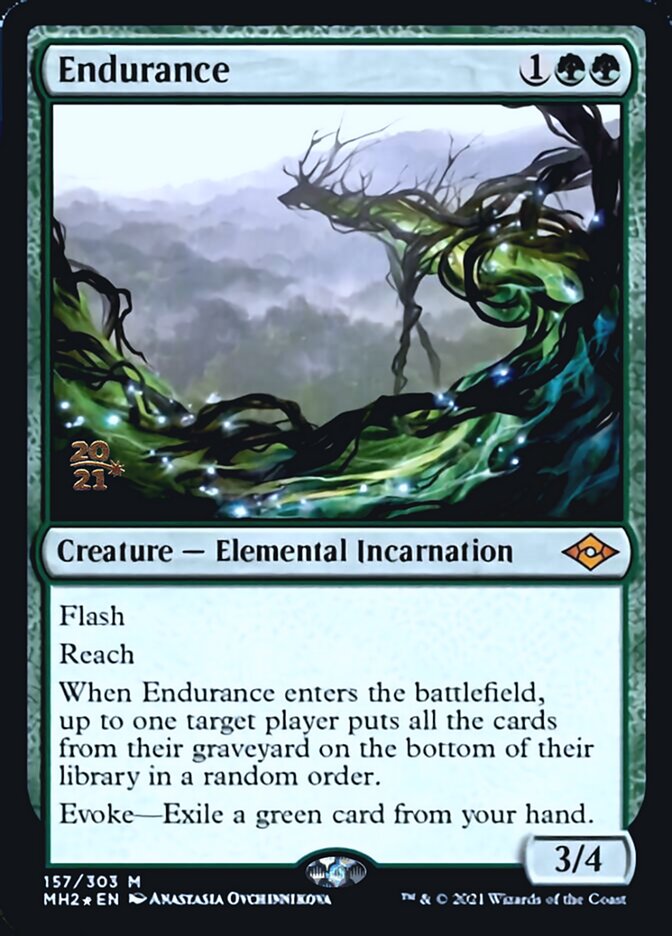
Modern Horizons 2’s evoke elemental creatures are tailor-made for Constructed play, and Endurance is no exception. Probably not as individually powerful as Fury or Solitude, but still worth playing, and now green has access to main deck graveyard hate in a pinch if needed. Also, a 3/4 flash and reach creature for three mana are a nice compliment to the ETB ability.
#7. Craterhoof Behemoth
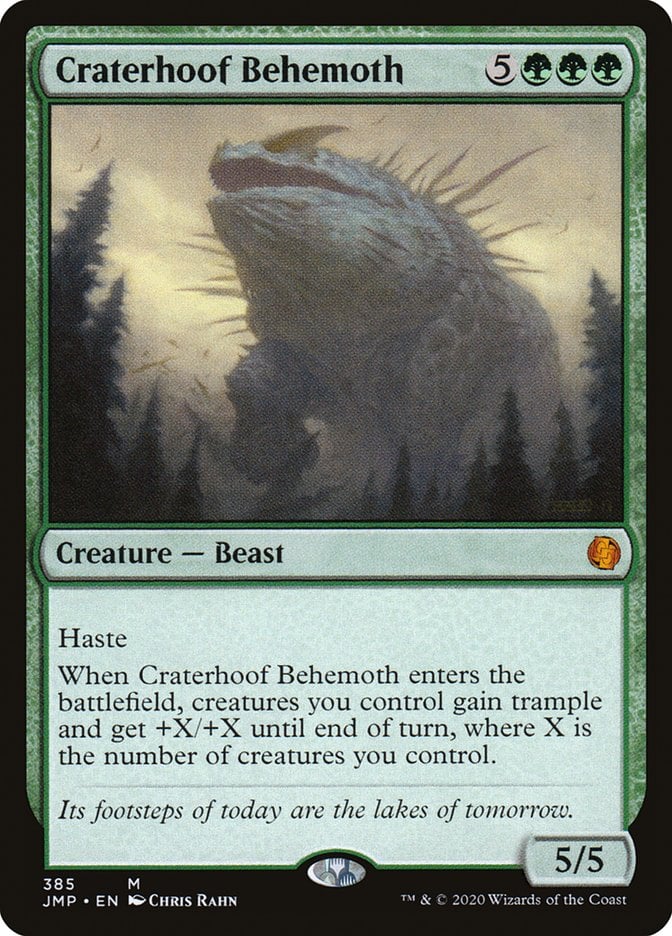
Craterhoof Behemoth, or “Hoof,” is a reason to play small creatures and mana dork. Craterhoof will give all your creatures +X/+X and trample, which usually ends the game on the spot. The problem is usually to find Hoof and put it into play, which can be done by drawing lots of cards or by tutoring.
#6. Primeval Titan
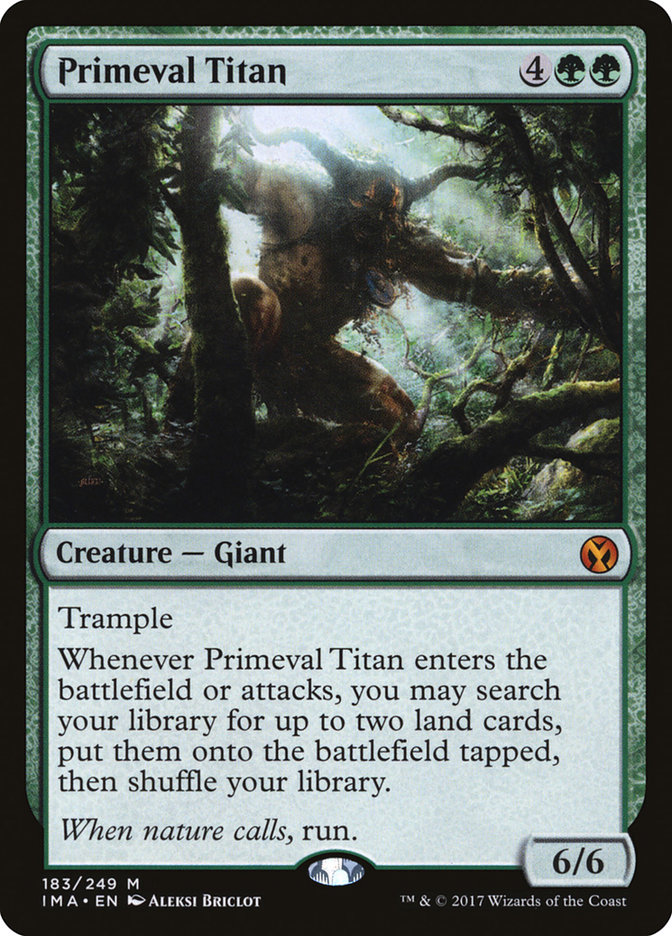
Primeval Titan, or “Prime Time,” is one of the more recognizable and powerful green creatures available. It’s a big 6/6 trampler whose main value is to search for any two lands and put them into play. The Titan alone can ramp you from 6 to 8, but the land tutoring has many implications in different formats, since you can choose between Slayers' Stronghold, Field of the Dead, or Valakut, the Molten Pinnacle, using your various lands as a toolbox.
#5. Vengevine
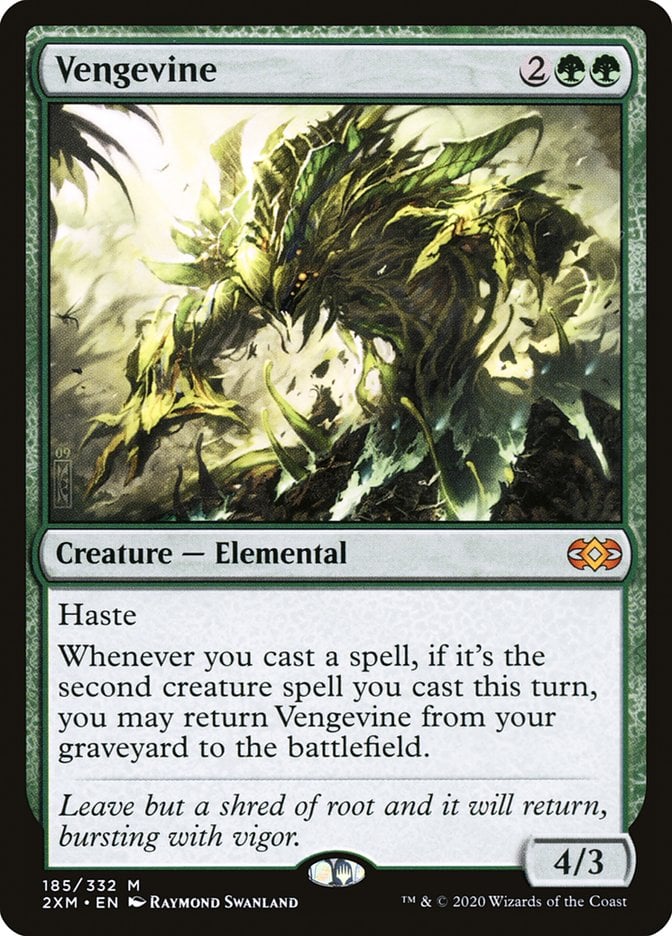
In the right decks, Vengevine is a 4/3 haste creature for free. And that’s it. If it’s in your graveyard, you’ll only need to cast two creature spells. Recurring threats that need to be exiled are usually very powerful and difficult to deal with for almost all decks, and Vengevine is a key piece in dredge decks since it benefits from self-mill and is one of the better payoffs for the strategy.
#4. Llanowar Elves + Fyndhorn Elves
Llanowar Elves is synonymous with the color green and MTG itself. The mana dork has always been a quintessential card in almost any green deck. The question is usually how many mana dorks you want to play in a given deck, ranging from 4 to 12+. Mana dorks with mana value 1 are deemed too powerful for the Standard format today, so it’s common to see even two-mana mana dorks being played for lack of better options.
#3. Noble Hierarch + Ignoble Hierarch
Noble Hierarch can generate three colors of mana, buff your attacking creatures thanks to the exalted bonus, and even attack as a 1/2 if needed. She’s one of the few mana dorks that has utility in the late game when the mana acceleration isn’t needed. Yes, Ignoble Hierarch is basically the same thing, the only difference being the colors of mana generated.
#2. Birds of Paradise
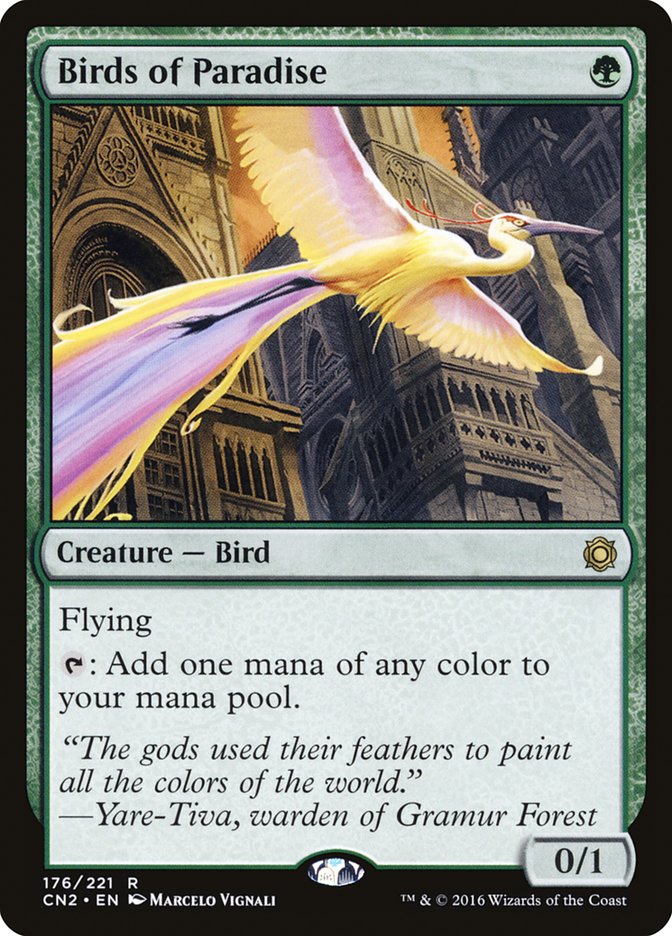
The sentence “Always Bolt the Bird” had to come from somewhere, and it got its origin because players realized it was necessary to cast Lightning Bolt to kill a Birds of Paradise ASAP. There’s a lot of flexibility to be had with BoP; you can generate mana from any of the five colors, block a flyer if needed, and you can even equip it. Birds of Paradise is the classic five-color mana dork, and it’s very powerful if left alive.
#1. Tarmogoyf
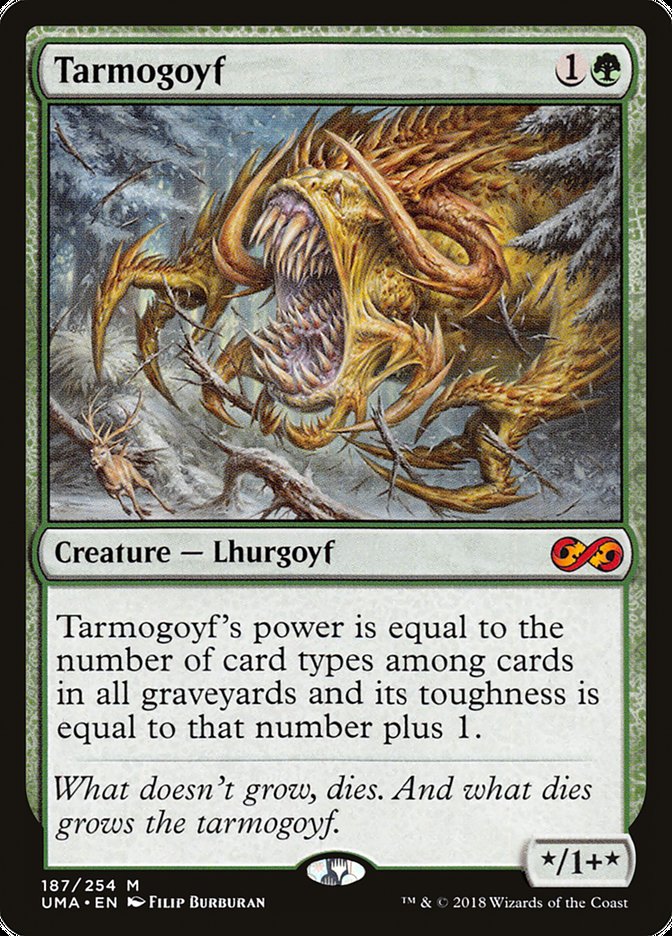
Probably the most common green creature played in MTG’s competitive scene, Tarmogoyf is a win condition that costs only two mana. It’s easy to splash in, say, decks, and all the while being an overstated creature. It’s common for “Goyf” to be a 3/4 for two mana already dodging Lightning Bolt, and also a creature that can be a 5/6 or even stronger. Combining Goyf with disruptive discard effects and planeswalkers is a tried-and-true way to build a midrange Constructed deck.
Best Green Creature Payoffs and Synergies
Green decks rely heavily on its big or numerous creatures, so we can use them in a lot of powerful ways:
Ramp! Green’s biggest strength in MTG is to generate tons of mana, so casting creatures that cost five mana and above is easier than in most colors. While your opponents are playing smaller cards, you’ll cast a 6-drop ahead of curve and have a great advantage.
Usually, mono-green decks are tribal elf decks, and the synergies available are in cards like Priest of Titania that generate a bunch of mana based on the number of elves you control, or cards like Craterhoof Behemoth, which will boost your elves for the win. In the same way, Gaea's Cradle is used to generate for each creature you control.
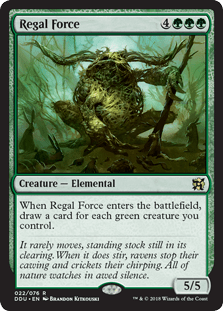
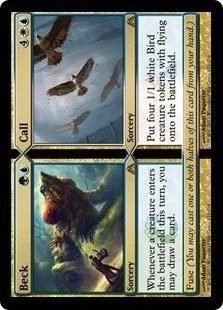
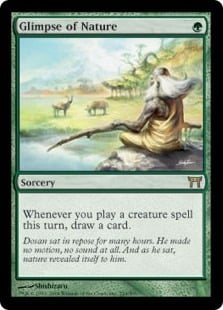
Regal Force is one of the best ways to draw cards in green creature decks since you’ll draw a card for each creature you control. Cards like Beck // Call or Glimpse of Nature are used in this regard to play lots of creatures and draw lots of cards.
There’s a subtheme in green cards that will benefit you by playing creatures that have power 4 or greater. You can take advantage of the big beefy creatures by drawing cards with Garruk's Uprising and Kiora, Behemoth Beckoner.
Put creatures into play without paying their mana costs like with Show and Tell, Sneak Attack, or reanimation. Good targets are Primeval Titan, Woodfall Primus, and Worldspine Wurm.
Wrap Up
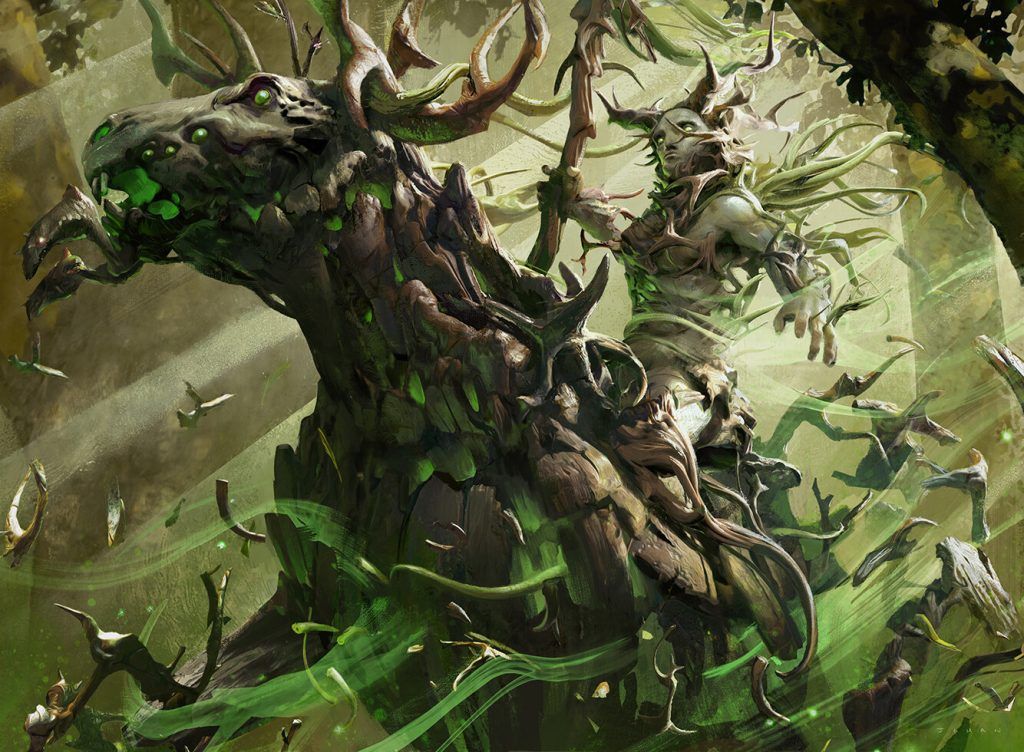
Cavalier of Thorns | Illustration by Jehan Choo
There we go folks, the best green cards ranked. Cards from this list can have different implications across many formats. Birds of Paradise is a Constructed staple, but you may want to play Elvish Mystic instead. But in a four-color EDH deck, BoP is clearly the better choice, as is a card like Bloom Tender, for example.
Green is a key color in EDH because its slow and steady style applies heavily to what EDH decks want, and as such, many of the cards here are better in the 100-card format than in 60-card Constructed formats like Modern or Legacy.
If your favorite card didn’t make it, let me know in the comments below. Or let’s discuss it in the Draftsim Discord. Either way, thanks for reading, and I’ll see you around!
Follow Draftsim for awesome articles and set updates:
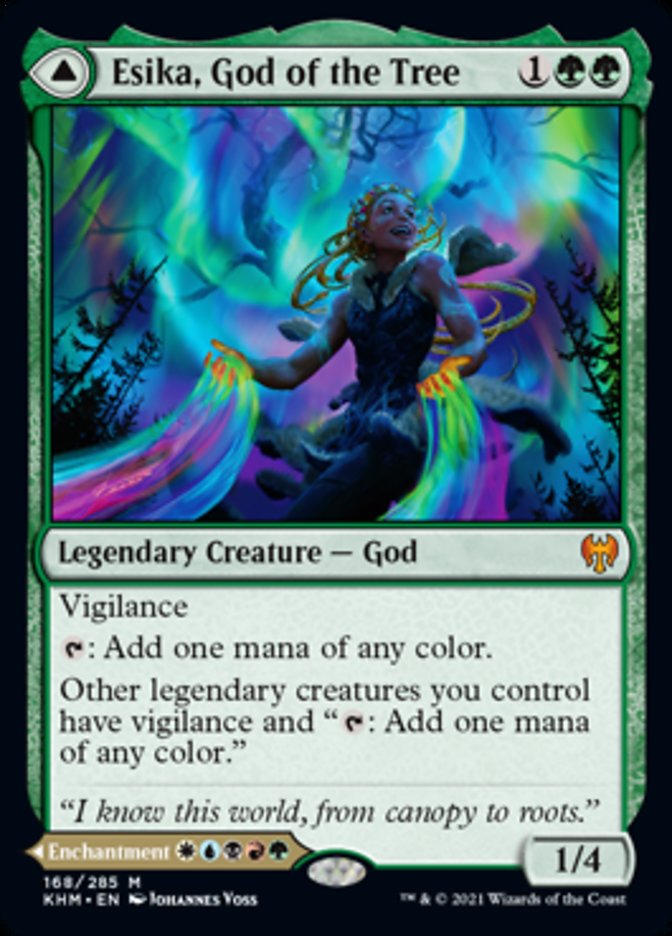

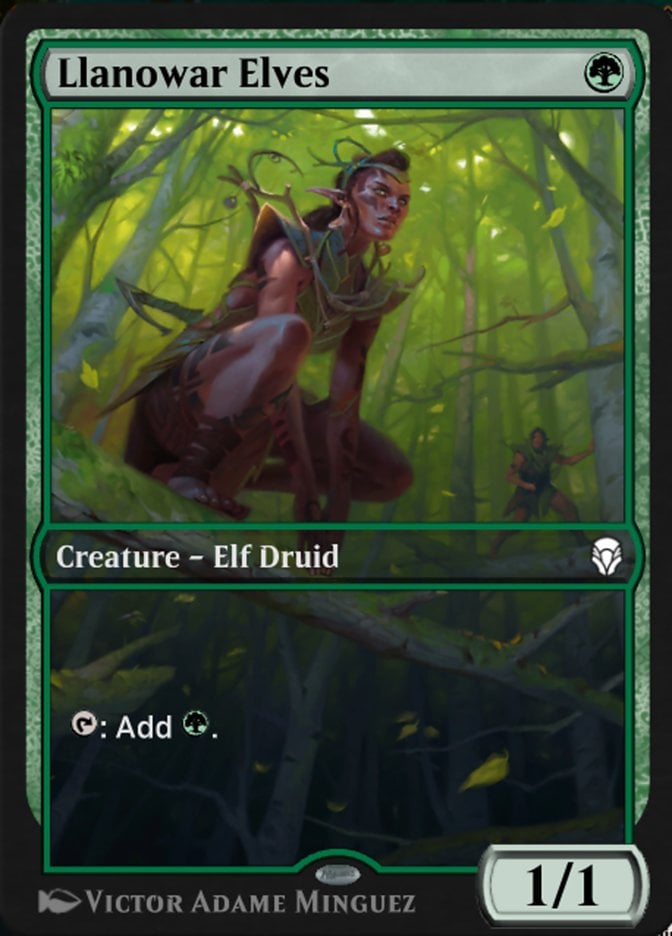
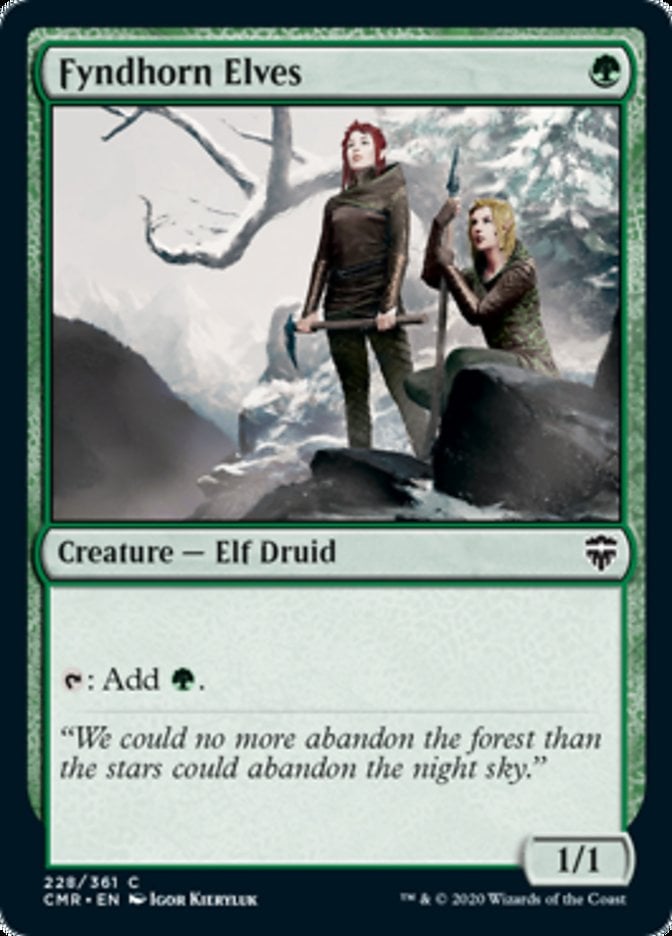
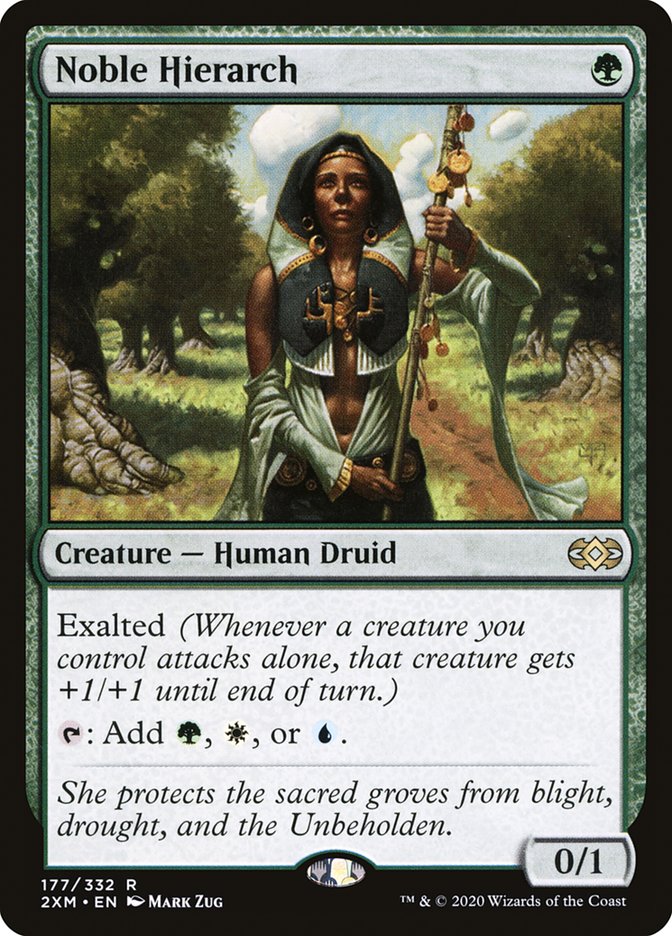
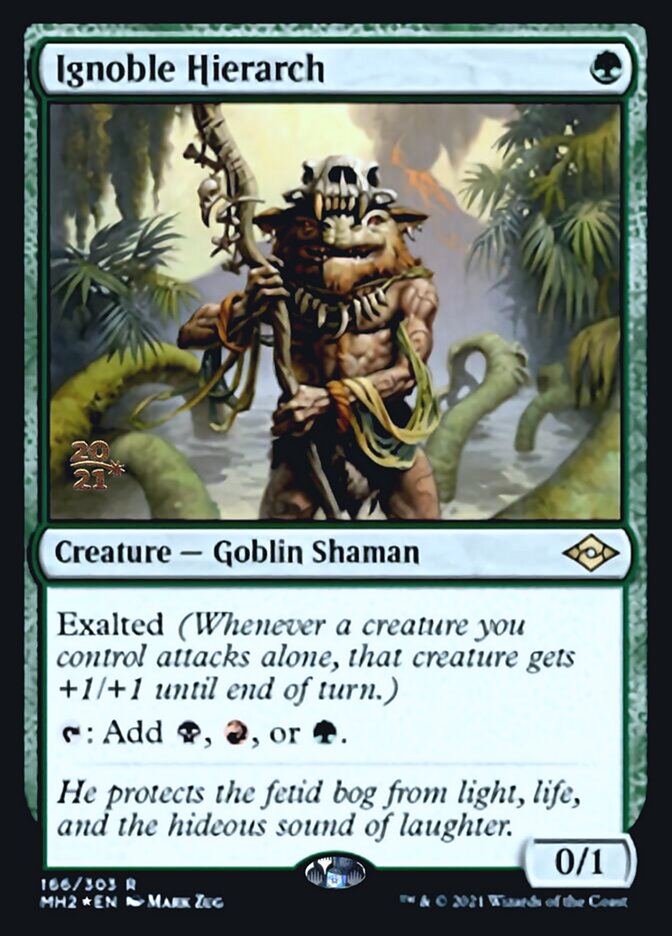
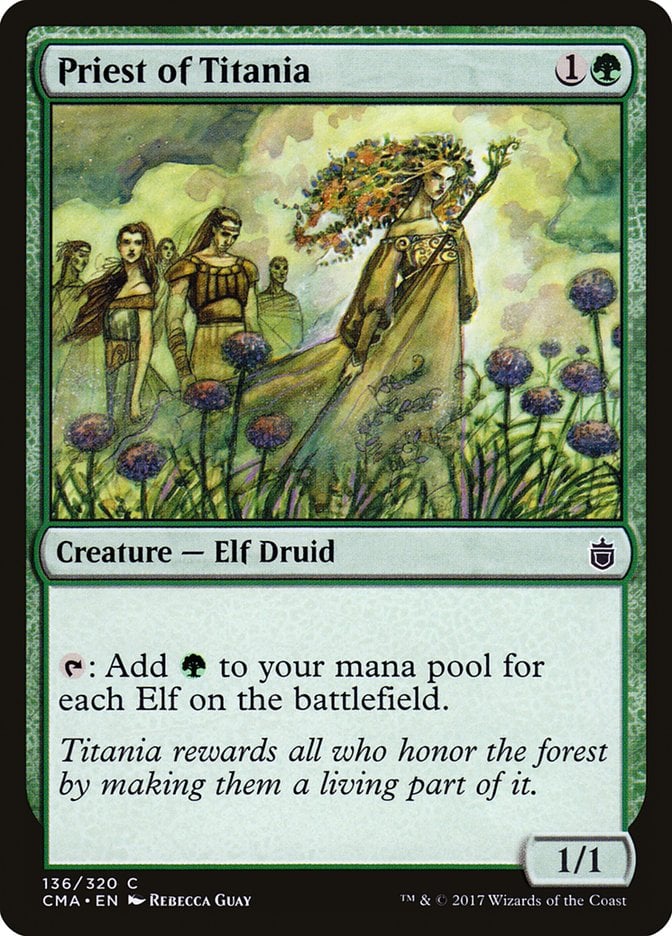
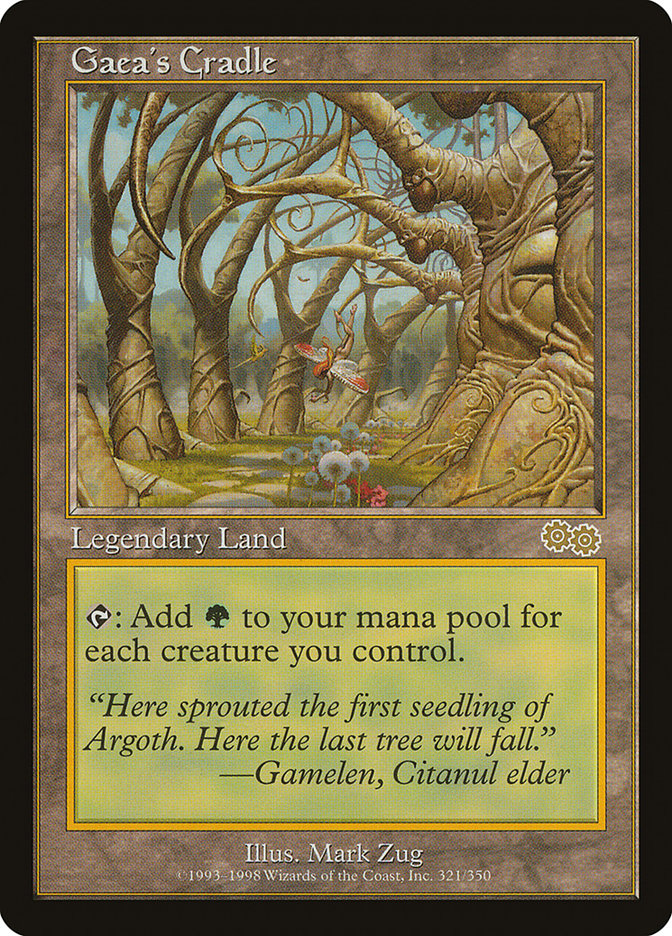
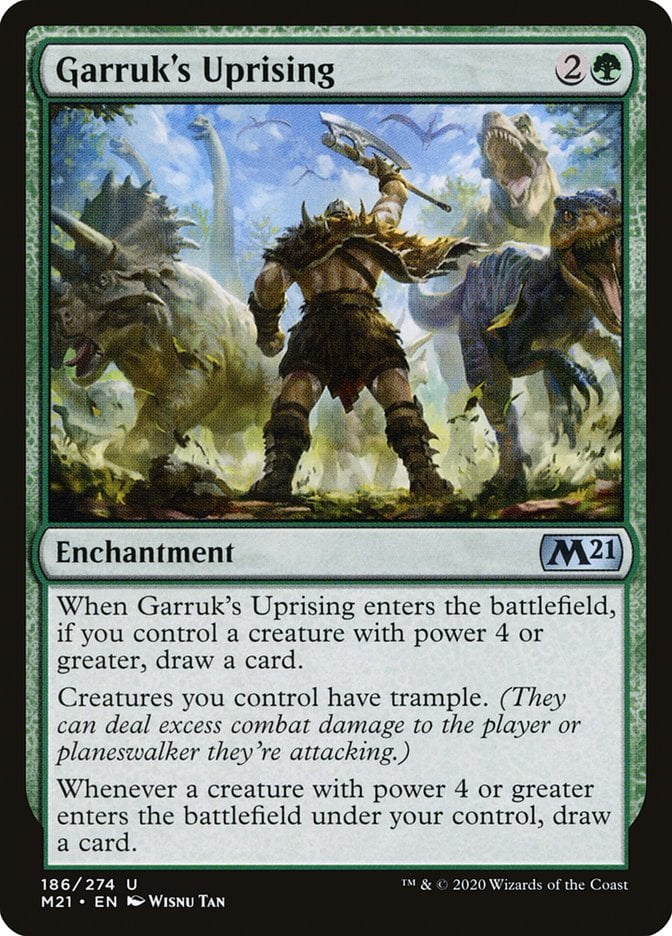
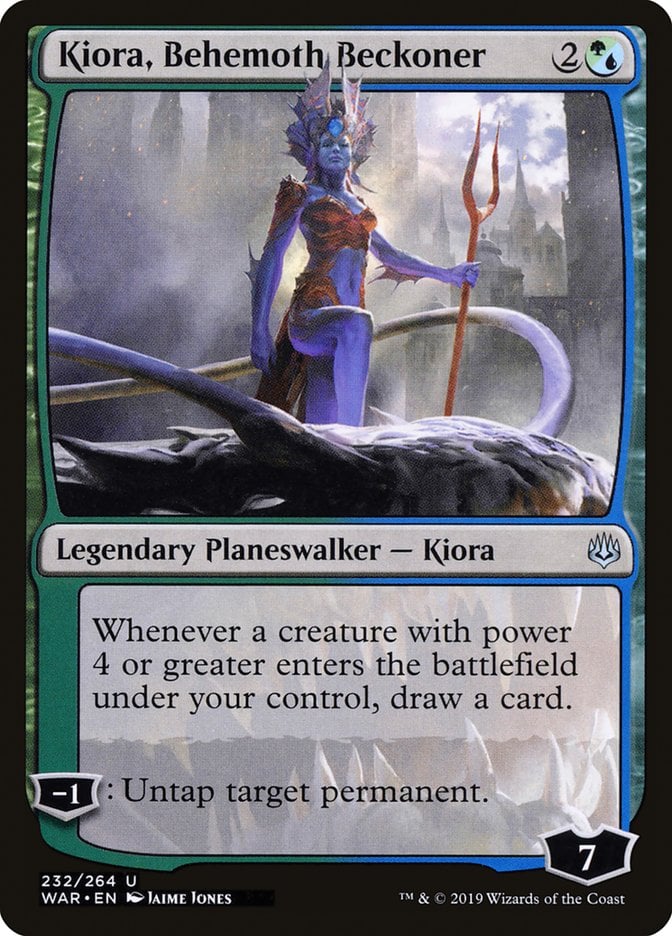
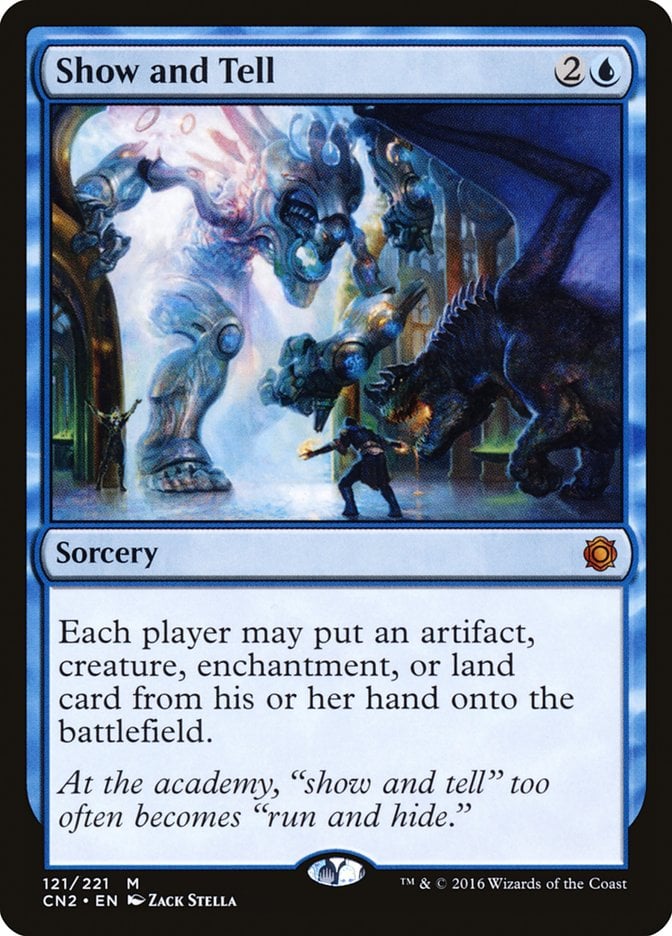
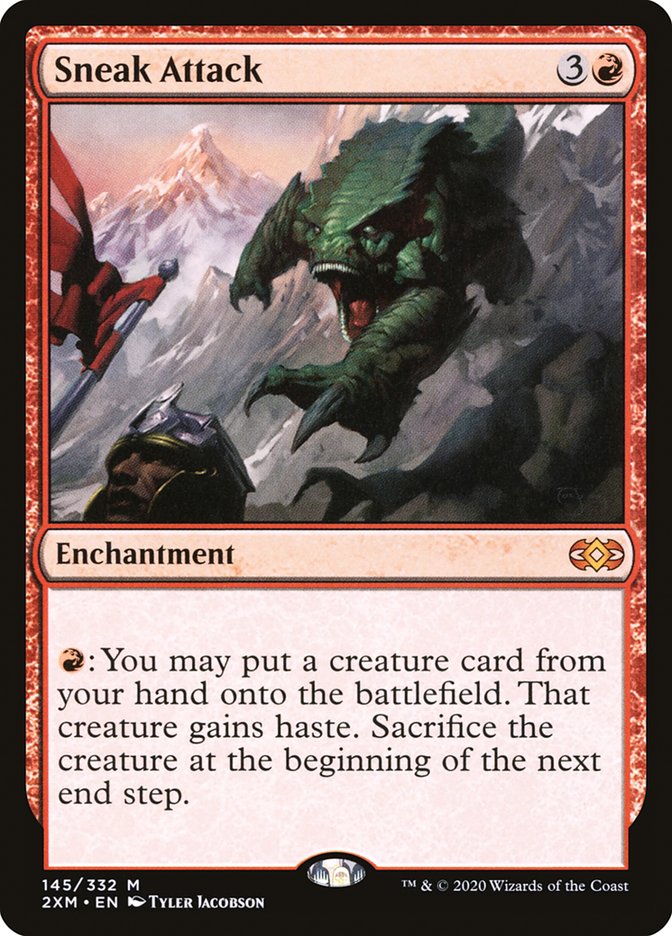
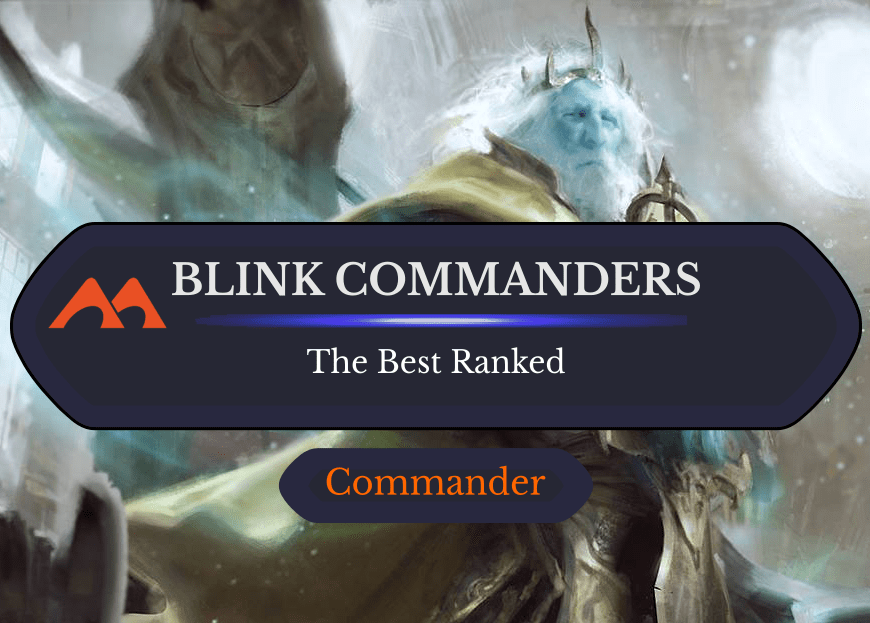
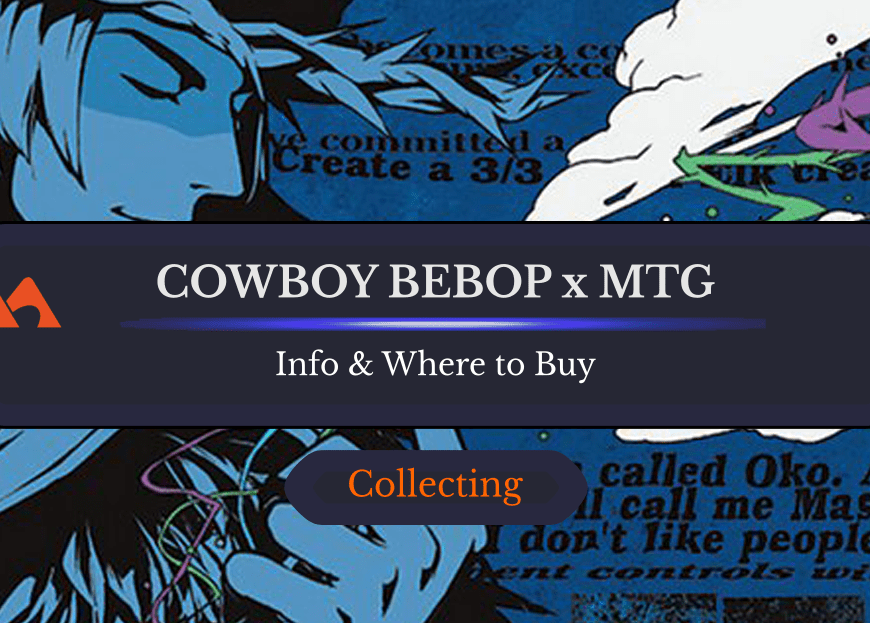
3 Comments
So disappointed that you didn’t have Priest of Titania as one of your top green cards. A one drop mana dork on turn one, followed by Quirion Ranger & Priest of Titania on turn two makes for insane mana shenanigans thereafter. And it was printed at common originally!
doesn’t vorinclex only deal with mana not with counters?
Fixed, thank you!
Add Comment